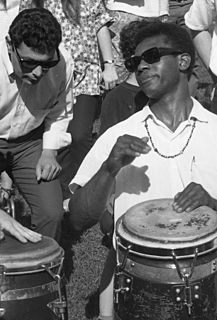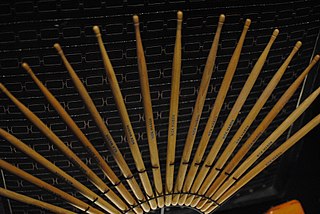Related Research Articles

The drum is a member of the percussion group of musical instruments. In the Hornbostel-Sachs classification system, it is a membranophone. Drums consist of at least one membrane, called a drumhead or drum skin, that is stretched over a shell and struck, either directly with the player's hands, or with a percussion mallet, to produce sound. There is usually a resonant head on the underside of the drum. Other techniques have been used to cause drums to make sound, such as the thumb roll. Drums are the world's oldest and most ubiquitous musical instruments, and the basic design has remained virtually unchanged for thousands of years.

A drum kit is a collection of drums, cymbals, and other auxiliary percussion instruments set up to be played by one person. Both hands of the player hold drum sticks, and their feet operate pedals that control the hi-hat and beater for the bass drum.

A percussion instrument is a musical instrument that is sounded by being struck or scraped by a beater including attached or enclosed beaters or rattles struck, scraped or rubbed by hand or struck against another similar instrument. Excluding zoomusicological instruments and the human voice, the percussion family is believed to include the oldest musical instruments.

The snare drum is a percussion instrument that produces a sharp staccato sound when the head is struck with a drum stick, due to the use of a series of stiff wires held under tension against the lower skin. Snare drums are often used in orchestras, concert bands, marching bands, parades, drumlines, drum corps, and more. It is one of the central pieces in a drum set, a collection of percussion instruments designed to be played by a seated drummer and used in many genres of music.

A drummer is a percussionist who creates music using drums.

Timpani or kettledrums are musical instruments in the percussion family. A type of drum categorised as a hemispherical drum, they consist of a membrane called a head stretched over a large bowl traditionally made of copper. Thus timpani are an example of kettle drums, also known as vessel drums and semispherical drums, whose body is similar to a section of a sphere whose cut conforms the head. Most modern timpani are pedal timpani and can be tuned quickly and accurately to specific pitches by skilled players through the use of a movable foot-pedal. They are played by striking the head with a specialized drum stick called a timpani stick or timpani mallet. Timpani evolved from military drums to become a staple of the classical orchestra by the last third of the 18th century. Today, they are used in many types of ensembles, including concert bands, marching bands, orchestras, and even in some rock bands.

A drum roll is a technique used by percussionists to produce a sustained sound for the duration of a written note.
All drum figures are based upon three fundamental beats, technically called roll, single stroke, and flam...Sustentation is accomplished upon wind instruments by blowing into the instrument; it is accomplished upon the violin and the allied instruments by drawing the bow across the string; it is accomplished upon the drum and allied percussion instruments by the roll.
THE SNARE DRUM ROLL.
The roll consists of an even reiteration of beats sufficiently rapid to prohibit rhythmic analysis. To produce an impression of sustentation, these beats must be absolutely even both in power and in sequence. Uneven beats in a roll destroy the impression of sustentation. Evenness is then the primary quality to strive for in roll; speed is the secondary quality to strive for.
There are two possible ways of producing an absolutely even sequence: (1) hand alternation of single stroke and (2) hand alternation of double strokes...The snare drum roll is produced by hand alternation of double strokes.
The "open roll" is produced by [initially] slow hand alternation. Two strokes in each hand alternately are produced by wrist movement and each beat should follow its predecessor in clock-like precision.

Carl Frederick Kendall Palmer is an English drummer best known as founding member and the last surviving member of the rock supergroup Emerson, Lake & Palmer. He was also a founding member of progressive rock supergroup Asia. He has toured with his own bands since 2001, including Palmer, the Carl Palmer Band, and currently, Carl Palmer's ELP Legacy. He previously was a touring drummer for The Crazy World of Arthur Brown and a founding member of Atomic Rooster.

Clash cymbals are cymbals played in matched pairs by holding one cymbal in each hand and striking the two together.

Marching percussion instruments are instruments specially designed to be played while moving. This is achieved by attaching the drum(s) to a special harness worn by the drummer, although not all marching bands use such harnesses and instead use traditional baldrics to sling their drums.

In rudimental drumming, a form of percussion music, a drum rudiment is one of a number of relatively small patterns which form the foundation for more extended and complex drumming patterns. The term "drum rudiment" is most closely associated with various forms of field drumming, where the snare drum plays a prominent role. In this context "rudiment" means not only "basic", but also fundamental. This tradition of drumming originates in military drumming and it is a central component of martial music.
Orchestral percussion refers to the various percussion instruments used in an orchestral setting. It may also refer to the act of playing such instruments in an orchestral style. Many music schools and conservatories offer training for musicians interested in developing their skills as an orchestral percussionist. Typically, an orchestral percussionist does not specialize in one particular instrument. Although there is no exhaustive list of all instruments that an orchestral percussionist must be able to play, there are particular instruments that are frequently used in orchestral repertoire. This includes timpani, snare drum, bass drum, xylophone, glockenspiel, triangle, and tambourine.

Martial music or military music is a specific genre of music intended for use in military settings performed by professional soldiers called field musicians. Much of the military music has been composed to announce military events as with bugle calls and fanfares, or accompany marching formations with drum cadences, or mark special occasions as by military bands. However, music has been employed in battle for centuries, sometimes to intimidate the enemy and other times to encourage combatants, or to assist in organization and timing of actions in warfare. Depending on the culture, a variety of percussion and musical instruments have been used, such as drums, fifes, bugles, trumpets or other horns, bagpipes, triangles, cymbals, as well as larger military bands or full orchestras. Although some martial music has been composed in written form, other music has been developed or taught by ear, such as bugle calls or drum cadences, relying on group memory to coordinate the sounds.
Henry Adler was an American jazz drummer, teacher, author, and publisher. He taught drummer Buddy Rich how to read music and co-wrote Buddy Rich's Modern Interpretation of Snare Drum Rudiments, published in 1942.

A Corps of Drums, also sometimes known as a Fife and Drum Corps, Fifes and Drums or simply Drums is a unit of several national armies. Drummers were originally established in European armies to act as signallers. The major historical distinction between a military band and a corps of drums, was that 'drummers' were not employed to play their instruments to entertain or delight, but rather they carried out a utilitarian battlefield role. This role was fulfilled by trumpeters or buglers in the cavalry and the artillery, who did not form into comparative formed bodies in the way that drummers did; therefore, an orthodox corps of drums will exist in the infantry arm.

A drum stick is a type of percussion mallet used particularly for playing snare drum, drum kit, and some other percussion instruments, and particularly for playing unpitched percussion.

Everett Joseph "Vic" Firth was an American musician and the founder of Vic Firth Company, a company that makes percussion sticks and mallets.

A fanfare band, fanfare corps, fanfare battery, fanfare team, horn and drum corps, bugle band, drum and bugle corps, or trumpet and drum band is a military or civilian musical ensemble composed of percussion instruments, bugles, natural horns and natural trumpets. Fanfare bands are the descendants of the old medieval trumpet and drum teams that sounded fanfares on important occasions and are related to drum and bugle corps internationally.

The percussion section is one of the main divisions of the orchestra and the concert band. It includes most percussion instruments and all unpitched instruments.
Morris Goldenberg was an American percussionist, music teacher, and method book author. He wrote several books on orchestral snare drumming, mallet percussion, and timpani. He is a member of the Percussive Arts Society Hall of Fame.
References
- ↑ Udow, Michael (2019). Percussion Pedagogy: A Practical Guide for Studio Teachers. Oxford University Press.
- 1 2 "The Carl e. Gardner Free Tension Drum".
- ↑ Gardner, Carl. Essentials of Music Theory. Carl Fischer, 1912.
- ↑ "Boston Symphony Orchestra Musicians List".
- ↑ Gardner, Carl E. The Military Drummer. Carl Fischer, 1918.
- ↑ Gardner, Carl E. Music Composition: A New Method of Harmony. Carl Fischer, 1918.
- 1 2 Beck, John H. Encyclopedia of Percussion. Routledge, 2013.
- ↑ Gardner, Carl E. The Gardner Modern Method for the Instruments of Percussion. Carl Fischer, 1919.
- ↑ Jacobs, Walter. Jacobs' Band Monthly. Volume 6, 1921.
- ↑ "Manufacturer of Instruments Organize Society in Boston". Music Trades, Volume 64, 1922.
- ↑ Soracco, Joseph P. "A DESCRIPTIVE ANALYSIS OF BUGLES, AND A SURVEY DETERMINING THEIR PREVALENCE AND STATUS IN THE PUBLIC SCHOOLS OF MASSACHUSETTS." BOSTON UNIVERSITY, 1951.
- ↑ Gardner, Carl E. Progressive Studies for the Snare Drum. Carl Fischer, 1928.
- 1 2 JOURNAL OF THE MUSIC SUPERVISORS NATIONAL CONFERENCE. Chicago, Illinois: April 15–20, 1928.
- ↑ "Eastern Conference, Boston - March 14–17." Music Educators Journal. Volume: 25 issue: 3, page(s): 48-51. December 1, 1938.
- ↑ "The Wartime Program in Action." Music Educators Journal. Vol. 29, No. 4 (Feb. - Mar., 1943), pp. 42-47.
- ↑ Iero, Cheech. "Talking Drums With Joe Cocuzzo." Modern Drummer. August/September, 1980.
- ↑ Reifel, Edward Martin. (2011) “Timpani: New Suggestions for Excerpt Practice Based on A Survey of Literature.” University of Toronto.
- ↑ Gardner, Carl (1945). Drums, Cymbals, Accessories. Carl Fischer.
- ↑ Gardner, Carl E. Reading Lessons for the First Year Drummer. Carl Fischer, 1950.
- ↑ Pearl, Jesse. (1971) Music: Instrumental Techniques and Percussion. US department of Health, Education, and Welfare.